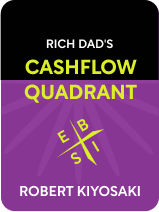

This article is an excerpt from the Shortform book guide to "Rich Dad's Cashflow Quadrant" by Robert T. Kiyosaki. Shortform has the world's best summaries and analyses of books you should be reading.
Like this article? Sign up for a free trial here .
What is the B quadrant? How does one break into Kiyosaki’s B quadrant from the E or S quadrants?
According to Kiyosaki, the B quadrant (big business owner) is a far likelier path to wealth than working in the E or S quadrants because you can take advantage of other people’s time to generate wealth. Kiyosaki says you have two choices when trying to establish yourself in the B quadrant: create your own business system, or buy one that already exists. Kiyosaki offers four routes to owning your own system in the B quadrant.
Here is how to break into the B quadrant, according to Kiyosaki.
What Is the B Quadrant?
In Robert Kiyosaki’s ESBI quadrant, people in the B category control not only a business, but a business system. If they leave, the work still gets done. People in the B category own their business and generate income by its profit, though they no longer do the day-to-day labor of making it function. A B’s income is the profit from their business, and their business is considered an asset. B’s need to be skilled in delegation and leadership, as well as have a high degree of financial literacy.
How to Break Into the B Quadrant
1. Find a mentor in the kind of business you want to enter. Remember Kiyosaki’s warning about whose advice you take. Make sure your mentor has actually succeeded in the field you want to enter and isn’t just someone who gets paid to dispense advice. (You’d be taking advice about being a B from a person who is an E—not a good idea, according to Kiyosaki.)
If you can do it, finding a mentor is one of the best ways to learn how to succeed in the B quadrant. A mentor will help you sift through the noise and will teach you what’s really important. Not only will a mentor teach you what they know, they can also be a sounding board and a guide as you learn by doing. Be sure your mentor is successful in the field you want to enter, not a professional advisor you’re paying.
(Shortform note: Research shows that having a mentor makes you better at your work, happier doing your work, and more likely to move up in your career. Three-quarters of people say having a mentor would help them, but more than half of people don’t have one. Once you scour your networks for a good candidate, experts recommend starting small and asking for an informational interview first. If the first meeting goes well, have specific goals your mentor can help you achieve, and make follow-up plans to keep the relationship going and hold yourself accountable.)
2. Work for a company in the field you want to work in for 10-15 years. After that amount of time, Kiyosaki says you’ll understand all the elements of that kind of business system and be ready to strike out on your own.
(Shortform note: The company you work for today could be your competition in the future. Even if your employer won’t be a primary competitor, you can learn a lot from studying competitors that sell to a slightly different audience, or that offer a different but related product.)
3. Buy a franchise. In the above two strategies, you’re learning to build a business system. When you own a franchise, the system already exists. Your job is to make sure the people who work for you are running the system as best as possible.
If you go this route, you have to do it by the book. Franchises aren’t for people looking to be creative in business.
| Pitfalls of Buying a Franchise In addition to having to follow someone else’s rigid rules for a business you own, there are a few other common pitfalls for franchisees: Hidden costs. Make sure you’re aware of all the fees you may be on the hook for when you buy a franchise, in addition to the share of profits you have to pay back to the company you franchised from. Misleading success statistics. Average revenue statistics may make your chances look better than they really are, because stand-out franchisees may be skewing a pool that actually earns much less. Franchises perform differently according to geography, so make sure you’re researching franchises in your area. Noncompete requirements. You may be barred from working in the same business sector for a certain amount of time or for a certain period of time after you sell your franchise. |
4. Try network marketing. Also called multi-level marketing, network marketing is another way to join a pre-existing business system, and it can be a good choice because you don’t need nearly as much capital (Kiyosaki says you can buy into a reputable network marketing organization for as little as $200). You also don’t need as much business acumen as you do when you buy a franchise, and the organization you work with can offer you valuable business education.
Network marketing gets a bad rap, but Kiyosaki says that if you can find an organization that aims to develop your business skills, leadership skills, and confidence, the experience can be well worth it. When you’re researching organizations, you should:
- Make sure the organization is interested in developing you, not in having you rope as many friends as possible into the organization so they can make more money in startup fees.
- Choose based on the quality of education and support they’ll offer you, not on the product. (But do make sure you believe in the product, so you’re doing work you can believe in.)
- Make sure you’ll be working with people you like and respect.
| Network Marketing Red Flags Some network marketing schemes are scams and can be classified as pyramid schemes. Like Kiyosaki alludes to, single-tier systems are safer than multi-tier systems, where top-tier salespeople make money off lower-tier salespeople and which can by pyramid schemes. Make sure you’re being paid from your product sales, not for recruiting others. Other red flags for pyramid schemes include: Claims of extremely high earning potential. If it sounds too good to be true, it probably is. Pressure from promoters. If anyone connected to the organization makes you feel like you’re under time pressure to make decisions or start working, they’re probably not reputable. Distributors buy more product than they’ll sell. This is a sign that the way to make money at that organization isn’t directly connected to how much product you sell. |
Note that MBAs are not one of Kiyosaki’s four routes to owning your own business: They’re a great way to get technical skills and a “fast track” to high management, but don’t teach you the full picture of what it really means to run a B category business.
(Shortform note: MBA programs also value real-world experience in their application processes. It may pay off to get some business experience before pursuing an advanced business degree.)

———End of Preview———
Like what you just read? Read the rest of the world's best book summary and analysis of Robert T. Kiyosaki's "Rich Dad's Cashflow Quadrant" at Shortform .
Here's what you'll find in our full Rich Dad's Cashflow Quadrant summary :
- Why the traditional path of college to career doesn't work
- Which types of income will lead you to financial freedom
- An in-depth look at Robert Kiyosaki's four cashflow quadrants






